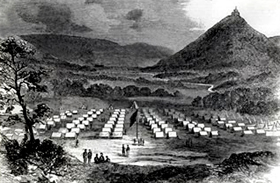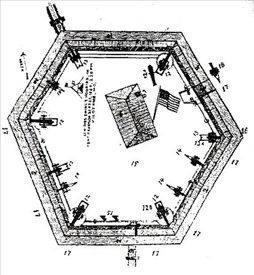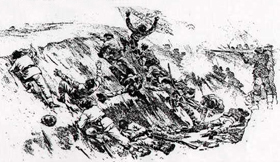Missouri Trails To The Past
Fort Davidson
 Fort Davidson (37°37'45"N90°38'24"W) was built by Union forces about 300 yards from the
base of Pilot Knob Mountain. The hexagonal earthwork fortress
was the target of the Battle of Pilot Knob in 1864 during
General Sterling Price's Expedition through Missouri.
Fort Davidson (37°37'45"N90°38'24"W) was built by Union forces about 300 yards from the
base of Pilot Knob Mountain. The hexagonal earthwork fortress
was the target of the Battle of Pilot Knob in 1864 during
General Sterling Price's Expedition through Missouri.
In September, 1864, Major General Sterling Price led his troops into Missouri with the goal of capturing St. Louis. Leading some 12,000 troops from Camden, Arkansas, Price began his Missouri Expedition, moving north toward Ironton, near the terminus of the Iron Mountain Railroad from St. Louis. On September 27th, the troops, along with seven large cannon, arrived just outside Pilot Knob, Missouri.
 Fort
Davidson was a tempting target and the troops began to bombard
the fortress. Led by Union Brigadier General Thomas Ewing, the
Union troops, though outnumbered by more than ten-to-one, the
managed to repulse repeated Confederate assaults on their
earthwork fortress. The fort occupied a strong defensive
position, with hexagonal walls nine feet high and ten feet
thick, surrounded by a dry moat nine feet deep. Two long rifle
pits ran out from the walls, while a reinforced board fence
topped the earthworks. Access could only be had through a
drawbridge on the structure's southeastern corner.
Fort
Davidson was a tempting target and the troops began to bombard
the fortress. Led by Union Brigadier General Thomas Ewing, the
Union troops, though outnumbered by more than ten-to-one, the
managed to repulse repeated Confederate assaults on their
earthwork fortress. The fort occupied a strong defensive
position, with hexagonal walls nine feet high and ten feet
thick, surrounded by a dry moat nine feet deep. Two long rifle
pits ran out from the walls, while a reinforced board fence
topped the earthworks. Access could only be had through a
drawbridge on the structure's southeastern corner.
Price's attack came as a massive assault from several directions. Though his troops engulfed the small Union force stationed within the town of Pilot Knob and another attacked and took control of Shepherd's Mountain, southwest of the fort, they would be unsuccessful in taking the troops at the fort itself. The guns at fort Davidson were directed at the Confederate forces, but, under fire and finding the earthworks too steep to climb, they were forced to retreat. The Confederates then made preparations to attack again the next day, building scaling ladders. In the meantime, General Ewing began to assemble his troops for an escape and the soldiers slipped away during the night by exploiting a gap in the Southern siege lines.
The next day, the soldiers were furious to find that the Union troops had gone and demanded that Price pursue them. However, the General had already lost over ten percent of his army and three precious days in this fruitless exercise. The Confederates took possession of the fort, but the attack resulted in a useless waste of men and ammunition, and ended Price's dream of seizing St. Louis for the Confederacy. Although the exact number of Confederate casualties are unknown, historians estimate that total Southern losses at the Battle of Fort Davidson were approximately 1,200, while Union losses were about 200.
The Rebel troops then advanced northward to Jefferson City, the state capital, but when they found it too heavily fortified moved west, fighting their way toward Kansas City, eventually suffering a crushing defeat at Westport. They then moved southward into Kansas, defeated once again at the Battle of Mine Creek, before finally returning to Arkansas, having lost half of their troops.
 Today,
the battle is commemorated at the Fort Davidson State Historic
Site in Pilot Knob, Missouri. The earthworks of the fort are
still generally intact, surrounding a huge hole that was caused
by a powder explosion. The dead were buried in a rifle pit in a
mass grave, which is marked by a granite monument. A visitor's
Center at the site provides detailed information and artifacts
from the battle.
Today,
the battle is commemorated at the Fort Davidson State Historic
Site in Pilot Knob, Missouri. The earthworks of the fort are
still generally intact, surrounding a huge hole that was caused
by a powder explosion. The dead were buried in a rifle pit in a
mass grave, which is marked by a granite monument. A visitor's
Center at the site provides detailed information and artifacts
from the battle.
Fort Davidson State Historic Site is located in Pilot Knob, Missouri off Highway 21 on Highway 221 in Iron County.
More Information:
Fort Davidson State Historic Site
P.O.
Box 509
Pilot Knob, Missouri 63663
573-546-3454